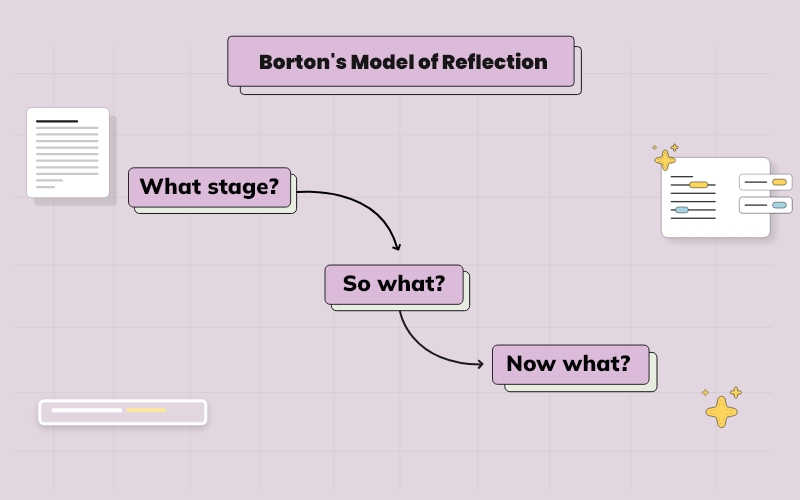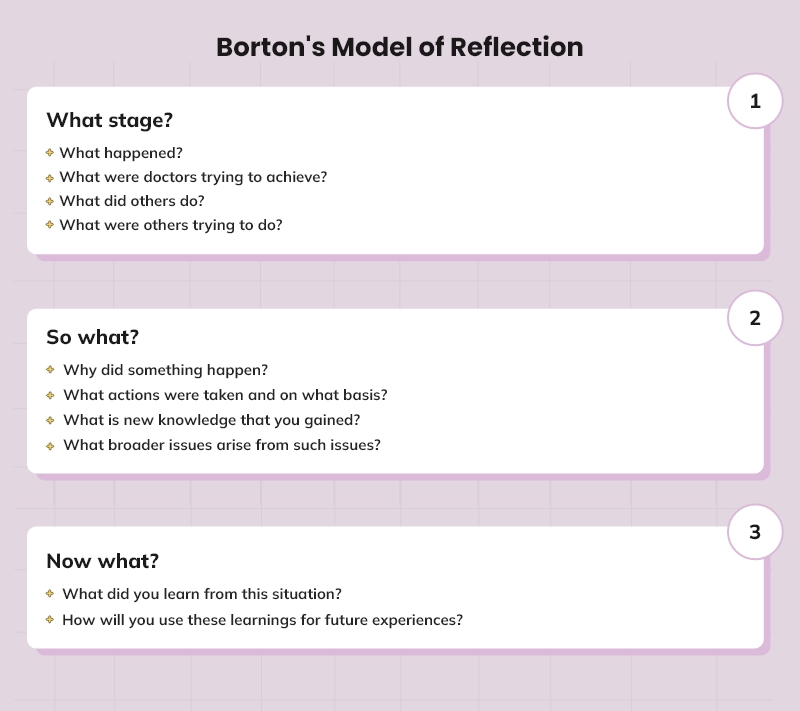
Overview
Borton reflective model was developed as a result of Borton’s work as a teacher. This model was developed on the basis of Rolfe et al’s framework developed by Rolfe et al. and the aim behind this model was to support reflection (Skinner & Mitchell, 2016). This model of reflection is based on three questions i.e. what? now what? and so, what? Borton reflective model was also published in the a1970 book “Reach, Touch and Teach”. Borton reflective model is one simple model of reflection that focuses on three questions to help individuals reflect on their experiences and better understand what happened, why it happened, and what can be done to improve things in the future.
Table of Contents
The first stage of this model focuses on a description of the event, the second stage includes a knowledge-building stage, and the third stage is an action-oriented stage of reflection that defines what can be done to improve things and enhance the overall quality of care for patients. This model of reflection is mainly used in clinical settings to reflect on nursing practices, weaknesses, and problems being faced in nursing practices and to prepare an action plan to improve the overall quality of nursing care and resolve various challenges (Skinner & Mitchell, 2016).
Three stages of Borton reflective model
Stage 1: What
The first step in this model of reflection is explaining the context of the situation to the readers. In this stage, you will explain the place, time, and context in which the event occurred. The following questions will help you in writing this section of the reflection.
- What happened?
In this, you will describe the contextual background of the situation you are reflecting upon. - What did you do?
While answering this question, you will highlight your actions during the occurrence of the event. - What was the result of your actions?
After describing your actions to the situation, you will highlight the consequences of your actions. - What do others involve in the situation did?
In this, you will highlight the actions of other people that were involved in the situation. - What was your reaction to it?
In this, you will highlight your reactions to the situation. It can be a positive or a negative reaction.

Stage 2: So what?
As said above, this is a knowledge-building stage where you will focus on highlighting your learnings from the situation and contributing to your self-improvement. The questions that can help you in writing this section of reflection are mentioned below.
- So what have you learned from the situation?
In this, you will focus on underlining your learnings from the whole situation. - So what could you have done?
In this, you will highlight the other actions that could have been taken by you and that could have led you to better results. - So what was the importance of this situation for you?
In this, you will highlight the value of this situation in your overall life learnings. - So on what basis did you take your actions?
In this, you will highlight the rationale on which you took the actions in the whole situation. - So what are you thinking about the situation right now?
Lastly, you will highlight your current thinking about the situation you are reflecting on.
Stage 3: Now what?
This is the last stage where you would highlight your future actions based on your learnings from the situation
- Now what have you learned?
In this, you will highlight your various learnings from the situation. - Now what will you do?
In this, you will highlight your future actions if a similar situation comes up again.
Now, we have seen that Borton reflective model is one of the important reflection models that can be used to reflect on a nursing situation. Let us now reflect on a nursing situation using this model.
Borton’s model of a reflection application example in nursing
Case assessment - This reflective example will focus on the nurse’s experience in the dementia ward. This reflection will highlight her experience of dealing with 5 dementia patients in which one of them gets out of control.
While working as a junior nurse during my second year of nursing placement in a dementia ward, I was required to ensure that the personal needs of patients are met which include effectively dealing with behavioral problems, proper medication being given, nutritional needs, etc (Hughes, 2008). There was one dementia patient named Jack who constantly sought attention. However, our ward contained 5 dementia patients, and managing such a large number of patients was very challenging. One day, when I failed to take care of Jack, Jack became violent and started fighting with all the other nursing staff members. This created a huge problem for us to deal with. I found his behavior to be very frustrating which also helped me in determining that I lack patience and empathetic behavior toward others. However, another nursing staff member changed their reaction to this situation and reassured Jack that they were on her side by saying “I am here, I will help you.” “Everything is alright.” This helped to calm down Jack. This also made me feel very disappointed as I found that I lack nursing capabilities. I also found that dementia care requires patience, skills, and listening abilities.
Being a nursing student, I was required to remain calm and adopt a friendly tone of voice to deal with Jack who was a dementia patient. I could also have reached out for more help in that situation but getting frustrated was the worst choice. This situation is important as this helped me to gain practical knowledge of nursing practice and identify my weaknesses. I took action only on the basis of my behavior without considering the problems and needs of a dementia patient. However, I believe that there were several other actions as well that could have helped to deal with the situation. I could have behaved calmly with Jack and could have accepted my mistake of not providing patient-centered care. Now, I believe that the quality of dementia care depends not only on the behavior of patients but also on the behavior of nurses. I also believe that higher attention is needed to be given to patients and focus is required to be placed on a dementia patient's behaviors.
After dealing with this situation, I found that I need to adopt a patient-centered care approach and improve my skills and behavior to prevent various issues from taking place. I also found that I need to engage in effective communication with all patients to understand a patient's concerns and needs. This can also help to prevent various behavioral issues in dementia care.Besides this, I also have decided to boost my emotional intelligence to better understand social situations and other people's feelings. This can help to prevent various conflicting issues from taking place. Moreover, I found that working with dementia patients is challenging at times due to workload, problems in managing psychological and behavioral symptoms associated with dementia, and hectic environments. Thus, I have also decided to practice medicine to improve my patience and work in such hectic and challenging environments.
FAQs
What are some of the limitations of Borton’s reflective model?
The simplicity of the Borton Reflective Model is one of its drawbacks since it might not adequately capture the complexity of some reflective experiences. The three-question format could be too constrictive for some people, and it might not offer enough structure or depth for in-depth meditation on more complex or emotionally charged events. A more thorough reflecting model with extra stages or components would be more appropriate in these circumstances.
Is the Borton Reflective Model more suited for use in professional contexts, or can it also be applied to personal life experiences?
Yes, both professional situations and private life experiences can benefit from using the Borton Reflective Model. Its straightforward three-question format lends itself to people reflecting on diverse facets of their lives, fostering personal growth, and learning from varied life circumstances.
Can a group use the Borton Reflective Model for collaborative reflection and learning?
Yes, the Borton Reflective Model works well for collaborative group work and learning in group situations. Each participant can discuss their answers to the three questions ("What?" "So What?" and "Now What?") pertaining to a shared event in a group environment. As a result, the situation can be better understood, other viewpoints can be encouraged, and there is room for group growth and advancement. Members of the group can use team work reflection and benefit from one another's ideas and work together to brainstorm potential courses of action and fixes for future problems.
Previous Model
Johns' model of reflectionNext Model
Schön model of reflectionReferences
Skinner, M., & Mitchell, D. (2016). “What? So What? Now What?” Applying Borton and Rolfe’s Models of Reflective Practice in Healthcare Contexts. Health And Social Care Chaplaincy, 4(1), 10-19. https://doi.org/10.1558/hscc.v4i1.28972
Hughes, R. (2008) Patient safety and quality an evidence-based handbook for Nurses. Rockville, MD: Agency for Healthcare Research and Quality.

 Proof Reading
Proof Reading  Copy Writing
Copy Writing  Resume Writing
Resume Writing  Blogs
Blogs Guides
Guides SOP's
SOP's Student Resources
Student Resources Research Topics
Research Topics Login
Login Register
Register